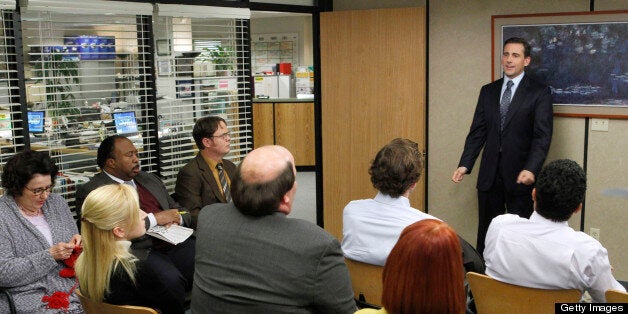
On May 16, the Dunder Mifflin Paper Company will close America's best-known office. After nine years, 'The Office', NBC's hit mockumentary about a dysfunctional workplace, will finally end its amazing run.
The end of 'The Office' is also an allegory for the real business world, as the sun begins to set on traditional bricks & mortar offices that have been the bedrock of American corporate culture for decades. As Dunder Mifflin packs its cubicles, it may be time for real businesses to take a hard look at their own, as the tradition of a Monday-to-Friday commute to the office is becoming obsolete.
Though telecommuting has been largely viewed by management as little more than a perk to attract and retain talent, in reality, studies have shown that it is actually a best practice that can fundamentally change a business, enabling it to succeed and prosper in today's challenging economic times. While a common myth persists that offices amplify a company's human resources, the reality is that offices consume as much as half of a business's productivity, right along with its cash and profit.
Here are some additional myths of the traditional bricks & mortar office:
Myth #1: Offices are the most productive places to get work done.
Studies have consistently found that offices are among the least productive places to get work done. Knowledge economy research and advisory firm Basex estimated that nearly 3 hours per day is lost to office-related interruptions and distractions, costing American businesses over $750 billion per year . If you ask an employee where they are most productive, chances are they will not tell you "at the office".
Technologies such as web conferencing, enterprise-class Internet phone systems and cloud storage mitigate the need for face-to-face interaction with co-workers. Software as a Service (SaaS) CRM solutions put the information employees need right in their hands whenever and wherever they need it, and virtual white boards foster highly-collaborative environments as if coworkers were in the same room.
Myth #2: Supervision is the key to productivity.
Do you know what the top web application used by closely supervised office workers is? If you guessed Salesforce or WebEx, you'd be wrong. The #1 web app used by bricks & mortar office workers is actually Farmville.
Whether employees are motivated and productive has little to do with where they work or how closely they're supervised. Instead, what makes a company turn and burn is its leadership - its ability to inspire employees with a compelling vision, translated into crisply defined goals and objectives. If employees understand where the company is going, are excited about that direction, and understand clearly how they're contributing to its success, they are an overwhelmingly powerful force, propelling the juggernaut forward.
Myth #3: Traditional Offices are not expensive.
Actually, bricks & mortar are very expensive. The combination of real estate, utilities, equipment, absenteeism, and lost productivity can cost the business as much as $40,000 per employee each year. Recruiting employees from an office-centric geographic area like Silicon Valley can dramatically drive up payroll. Additionally, costs from catastrophic events can prove insurmountable to businesses anchored in a traditional office. Last year's hurricane Sandy cost downtown New York City businesses and estimated $17 billion Much of this was due to downtime--employees were simply unable to work because they had no place to work and no infrastructure with which to work.
A distributed home-based workforce is the new disruptive best business practice of the 21st century. Cloud based infrastructure, like eVoice, Salesforce, and eFax eliminates the need for expensive and inefficient office-based IT hardware, software, and personnel. Borderless security solutions like Cisco's eliminate the need for previous-generation firewall citadels.
The goal for today's business leaders is not to get employees to the office - it is instead to liberate their workers from the office altogether, freeing up found stores of productivity and profit in the process. Telecommuting breaks the traditional confines of the office that restrict employee productivity and company agility. Current generation cloud solutions enable a workforce, motivated by visionary leadership, to work anywhere, anytime. As one 'Office' comes to an end, it is time to begin closing the rest.
Related
Sign up for Peacock to stream NBCU shows.
to stream NBCU shows.
